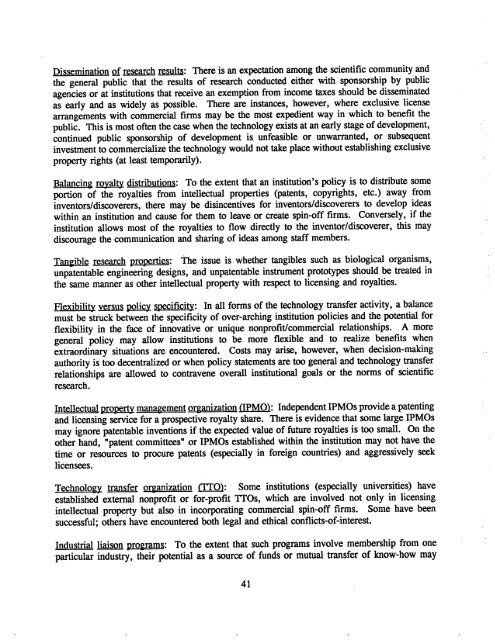WHOI-90-52
WHOI-90-52
WHOI-90-52
You also want an ePaper? Increase the reach of your titles
YUMPU automatically turns print PDFs into web optimized ePapers that Google loves.
Dissemination Qf resech results: There is an expetation among the scientific community and<br />
the general public that the results of resech conducte either with sponsorship by public<br />
agencies or at institutions that recive an exemption from income taes should be disseminated<br />
as ealy and as widely as possible. There are instaces, however, where exclusive license<br />
argements with commercial firms may be the most expeient way in which to benefit the<br />
public. This is most often the case when the tehnology exists at an ealy stage of development,<br />
continued public sponsorship of development is unfeasible or unwarte, or subseuent<br />
investment to commercialize the tehnology would not tae place without establishing exclusive<br />
property rights (at least temporarly).<br />
Balancing royalty distributions: To the extent that an institution's policy is to distrbute some<br />
porton of the royalties from intellectua propertes (ptents, copyrights, etc.) away from<br />
inventors/discverers, there may be disincentives for inventors/discoverers to develop ideas<br />
within an institution and cause for them to leave or create spin-off firms. Conversely, if the<br />
institution allows most of the royalties to flow directly to the inventor/discverer, this may<br />
discurage the communication and sharng of ideas among staff members.<br />
Tangible reseach properties: The issue is whether tagibles such as biologica organisms,<br />
unpatentable engineering designs, and unpatentable instrment prototyps should be treated in<br />
the same manner<br />
as other intellectual propert with respet to licensing and royalties.<br />
Flexibilty versus ~ speificity: In all forms of the tehnology transfer activity, a balance<br />
must be strck between the speificity of over-arching institution policies and the potential for<br />
flexibilty in the face of innovative or unique nonprofit/commercial relationships. A more<br />
genera policy may allow institutions to be more flexible and to reaze benefits when<br />
extraordinar situations are encountered. Costs may arse, however, when decision-makng<br />
authority is too decntraliz or when policy statements are too general and technology trsfer<br />
relationships are allowed to contrvene overal institutional goals or the norms of scientific<br />
resech.<br />
Intellectual property management organization (JPMO): Independent IPMOs provide a patenting<br />
and licensing service for a prospetive royalty share. There is evidence that some large IPMOs<br />
may ignore patentable inventions if the expeted value of future royalties is too smal. On the<br />
other hand, "patent committees" or IPMOs established within the institution may not have the<br />
time or resources to procure patents (espeially in foreign countres) and aggressively sek<br />
licenses.<br />
Technology trsfer organization (IO): Some institutions (espeially universities) have<br />
established external nonprofit or for-profit TIOs, which are involved not only in licensing<br />
intellectu property but also in incorprating commercial spin-off firms. Some have been<br />
successful; others have encountered both legal and ethica conflcts-of-interest.<br />
Industral liaison programs: To the extent that such programs involve membership from one<br />
paricular industr, their potential as a source of funds or mutual transfer of know-how may<br />
41
















